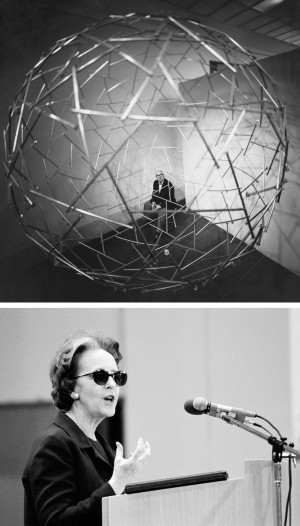Adam Rome revisits five prescient classics that first made sustainability a public issue in the 1960s and 1970s.
The Meaning of the Twentieth Century: The Great Transition
- Kenneth E. Boulding
Operating Manual For Spaceship Earth
- R. Buckminster Fuller
The Closing Circle: Nature, Man, and Technology
- Barry Commoner
The Limits to Growth: A Report for the Club of Rome's Project on the Predicament of Mankind
Donella H. Meadows, Dennis L. Meadows, Jørgen Randers, and William W. Behrens III. Universe: 1972.
9780876632222
Only One Earth: The Care and Maintenance of a Small Planet
Barbara Ward and René DuBos. W. W. Norton: 1972.
In 1969, in a book-length essay entitled Operating Manual for Spaceship Earth, the inventor and polymath Buckminster Fuller offered a striking metaphor for a new ideal of planetary management. Although Earth did not come with instructions, our spaceship had built-in safety features that had kept us going. Still, our pilot errors were catching up with us: we had been so “misusing, abusing, and polluting” the planet, Fuller argued, that it might need to be renamed “Poluto”. That way lay humanity's oblivion. But if we discovered how our spaceship worked — if we learned to make the best use of our incredible ingenuity — we might become “comprehensively and sustainably successful”.
Like everything Fuller wrote, Operating Manual for Spaceship Earth was idiosyncratic, at once arresting and fanciful. But many of the book's basic ideas were in the air at the time. Between roughly 1965 and 1975, the challenge of sustaining civilization inspired a shelf-full of influential books. They had a freshness, urgency and breadth that are hard to credit today, and they are still remarkably relevant. Now that sustainability as a concept has become dulled by overuse, they return our eyes to the prize.

These seminal studies built on earlier fears. Fairfield Osborn's Our Plundered Planet (Little, Brown) and William Vogt's Road to Survival (W. Sloane Associates), both published in 1948, warned that uncontrolled population growth and resource depletion would lead to calamity. But the situation seemed even more precarious by 1970, when the first Earth Day was celebrated across the United States. The human impact on the planet had exploded after the Second World War, and scientific advances had led to greater understanding of the threat from those impacts. For the first time, many realized, we had the potential to disrupt or even destroy the planet's life-support systems. The sense of environmental crisis was exacerbated by the social and political turmoil of the period.
What would be required for humanity to continue to thrive? To tackle so huge a question required intellectual audacity, and the authors of the pioneering books on sustainability were all big-picture, interdisciplinary thinkers par excellence. Economist Kenneth Boulding — author of The Meaning of the Twentieth Century (1964) — thought historically and philosophically. Biologist Barry Commoner felt compelled to study political economy, as his 1971 The Closing Circle shows. Fuller considered himself a futurist. The authors of the 1972 The Limits to Growth — Donella Meadows, Dennis Meadows, Jørgen Randers and William Behrens — meshed environmental science with systems analysis. Barbara Ward was a journalist, economist and adviser to world leaders who collaborated with Pulitzer-prizewinning microbiologist René Dubos on Only One Earth (1972).
The Meaning of the Twentieth Century is no longer well known, yet Boulding was key in framing the issue of sustainability. He made clear that the world that he hoped to sustain did not yet exist: humanity was in the middle of a “great transition” from an agricultural species to a thoroughly industrial one. In Boulding's view, this transition was fraught with peril and sure to be wrenching. It might be derailed by nuclear war or uncontrolled population growth, and might fail if we misused natural resources, especially fossil fuels. To succeed, we needed to create “a stable, closed-cycle, high-level technology” that would not pollute or require exhaustible materials. (He expanded on that in an often-reprinted 1966 essay, 'The economics of the coming spaceship Earth'.) But developing new technology was not the heart of Boulding's prescription. He argued that a sustainable future would require countless “social inventions”, from new aesthetics to better methods of resolving disputes. “The unfinished tasks of the great transition are so enormous,” he concluded, “that there is hardly anyone who cannot find a role to play in the process.” That is still ever true now: dealing with climate change requires a host of skills.


Fuller broke new ground by defining sustainability as a design challenge. Already famous for inventions such as the strong, lightweight, geodesic dome, he wrote exuberantly about the need for an “industrial retooling revolution”: to achieve lasting affluence, we must learn to do more with less. Like Boulding, Fuller argued that we needed to treat fossil fuels as a short-term expedient while we worked out how to fashion a sustainable future. For a reader today, the insights of Fuller's work are not enough to make up for the idiosyncrasies of his language and argument. William McDonough and Michael Braungart's Cradle to Cradle (North Point, 2002) would be a much better introduction to sustainable design. But in 1969, Fuller's work seemed thrilling, and his Operating Manual became a bible for people keen to invent eco-efficient ways of providing energy, building things and managing wastes.
Commoner's The Closing Circle laid the foundation for industrial ecology. Particularly in the postwar decades, Commoner argued, the industrialized world had come to rely on a host of “ecologically faulty” technologies, from nuclear power to chemical pesticides. The technologies of the future needed instead to accord with four basic principles, which he defined as laws of ecology: “Everything is connected to everything else”, “Everything must go somewhere”, “Nature knows best” and “There is no such thing as a free lunch”.
For Commoner, however, the ultimate problem was economic and political, not technological. Discussing the economic meaning of ecology, he argued that the private-enterprise system had serious flaws. Businesses had powerful incentives to produce new products that did more environmental harm than the products they replaced. They did not need to account for “biological capital”, and they did not pay the full costs of production, which included pollution. In the decades since The Closing Circle appeared, making capitalism greener has become a major concern of economists, business-school professors, entrepreneurs, corporate executives and activists, yet much of Commoner's critique still holds.
The Limits to Growth asked — heretically — whether humans could continue indefinitely to make ever greater demands on Earth. The authors used computer modelling to explore the interactions between population growth, resource demand, industrialization, food production and pollution. They did not forecast the future, although commentators ever since have debated whether their 'predictions' were right; instead, they extrapolated. If present trends continued, the authors wrote, humanity would hit the wall “sometime within the next hundred years”. They hoped that people would avert a breakdown, but stated repeatedly that they could not model the social, political and cultural factors that might alter trends. They did consider whether technology could be a magic bullet, and the results were shocking. Even when they allowed for the technological progress that greatly increased the availability of resources and reduced the amount of pollution, the result was still collapse — just farther down the road. Innovation alone could not lead to a sustainable economy. We needed a fundamental shift in values.
The Limits to Growth was an international sensation, selling over 12 million copies in more than 30 languages. Meadows, Meadows and Randers updated the analysis in 1993 and again in 2004, and the question of limits still prompts vigorous debate. Johan Rockström and Mattias Klum's Big World, Small Planet (Yale University Press, 2015) and Donald Worster's Shrinking the Earth (Oxford University Press, 2016) are just two of the many books now probing the problem of growth.
Ward and Dubos's Only One Earth, written to accompany the 1972 United Nations Conference on the Human Environment, added an international perspective to the sustainability discussion. Ward had travelled the globe as an expert on economic development. A preliminary draft of the book was circulated for comment to scientific, business and intellectual leaders from 58 countries, and the result is worth reading just for the summary of their responses, which made clear that people around the world held very different views about environmental issues. A European respondent argued for a retreat from industrialization, for example, whereas an Asian statesman wrote that developing nations could not afford “dreams of landscapes innocent of chimney stacks”.
For Ward and Dubos, any effort to ensure the survival of humanity had to bridge the tremendous gap between developed and developing nations. Although they didn't use the phrase 'sustainable development', they offered a path-breaking analysis of the challenge of raising living standards for the poor without degrading the environment. At the same time, they called for the affluent to take off their blinkers. Well-to-do nations needed to acknowledge the damage that they were doing to the biosphere — and to accept that their fate was inseparable from the prospects of the rest of the world. Because many environmental threats were global, Ward and Dubos concluded, “planetary interdependence” had to become a moral and political reality, not just “a hard and inescapable scientific fact”. The UN Paris Climate Change Conference starting this month will be a test of how close we are to meeting that aim.
Read together, the books of this charged decade demonstrate that building a sustainable civilization is multidimensional. It sweeps everything in: science and technology, politics, economics, social relationships, ethics. We cannot advance in a straight line. We need to approach the goal from many directions, with flexibility and tenacity.
Author information
Authors and Affiliations
Corresponding author
Related links
Related links
Related links in Nature Research
Sustainability science: Exploiting the synergies
Material Witness: Freedom to build
Overseas Aid in its Proper Perspective
Nature special: 2015 Paris Climate Change Conference
Nature special: Sustainability
Related external links
Rights and permissions
About this article
Cite this article
Rome, A. Sustainability: The launch of Spaceship Earth. Nature 527, 443–445 (2015). https://doi.org/10.1038/527443a
Published:
Issue Date:
DOI: https://doi.org/10.1038/527443a
This article is cited by
-
Coordinated development of land multi-function space: An analytical framework for matching the supply of resources and environment with the use of land space for ecological protection, agricultural production and urban construction
Journal of Geographical Sciences (2023)
-
Forecasting and controlling of municipal solid waste (MSW) in the Kaohsiung City, Taiwan, by using system dynamics modeling
Biomass Conversion and Biorefinery (2022)
-
Circular economy: Getting the circulation going
Nature (2016)
